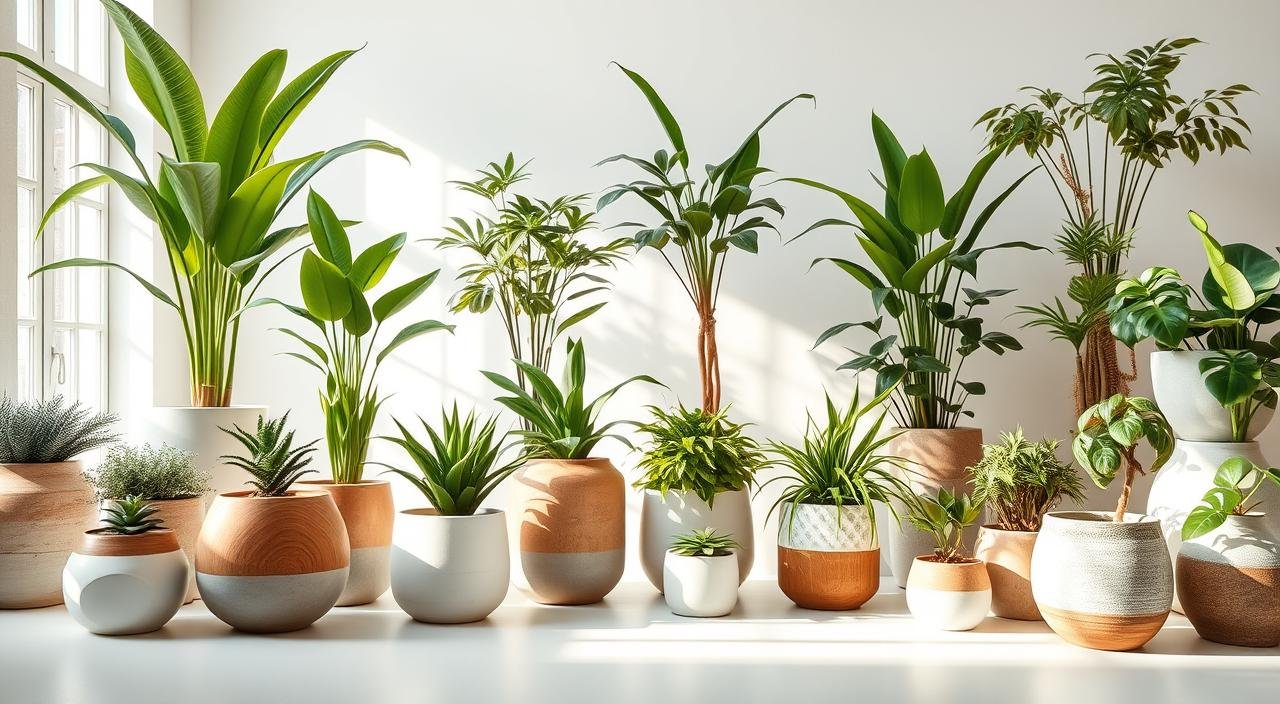Over 525 indoor planters are available, but only 1 in 5 gardeners know how pot choices impact plant survival. A poorly draining pot can kill a houseplant faster than neglect—yet 9 out of 10 indoor plants thrive in pots with proper airflow and moisture control. Prices range from $8.99 for the Providence Eloise Planter to $34.99 for the Dachshund Dog Pot, with 5-star rated options like the $9.99 Blue Embossed Ceramic Pot (rated by 14 customers) leading the way.
Key Takeaways
- 525+ indoor planter options exist, with prices from $8.99 to $35+.
- 5-star rated pots like the Dachshund Dog Pot (14 reviews) highlight top performer.
- Clearance savings over 50% and 10% insider perks discounts simplify budget-friendly choices.
- Drainage holes and breathable materials are critical for plant root health.
- Ceramic and synthetic options like the $9.99 Crosby St. Stripe Planter balance style and cost.
Choosing the Right Pot for Your Indoor Plants
Selecting the right container starts with material choices. Terracotta pots dry faster than plastic, making them ideal for succulents like sansevieria. Ceramic pots are popular for their style but often lack drainage holes. Plastic options remain budget-friendly and lightweight.
Understanding Pot Materials
- Clay/terracotta: Porous material reduces overwatering risks for drought-tolerant plants.
- Ceramic: Aesthetic top choices but require drainage solutions like adding a saucer.
- Plastic: Best for beginners due to affordability and moisture retention.
Size Matters: How to Choose the Right Size
Follow these guidelines for healthy root growth:
- Small plants (≤10″ diameter): Increase by 1-2″.
- Larger plants (>10″ diameter): Increase by 2-3″.
- Example: A 4″ ZZ plant moves to 5″ pot; 12″ philodendron becomes 14″.
Drainage: Why It’s Essential
Containers without drainage holes increase root rot risk by 70% in indoor gardening setups.
Solutions include using a plastic nursery pot inside decorative covers or adding gravel layers. Repotting every 1-2 years prevents overcrowding, crucial for plant care success.
Decorative Containers for Indoor Plants
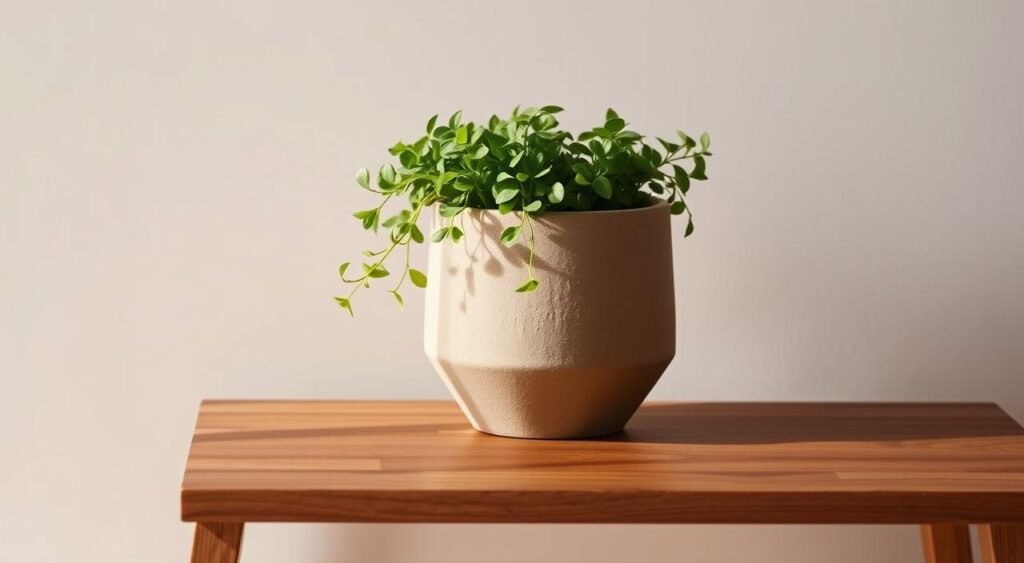
Decorative containers for indoor plants blend style and function, turning greenery into focal points of indoor plant decor. The right container enhances rooms while meeting plant needs like drainage and moisture control. Brands like West Elm and Home Depot offer options from modern to rustic, ensuring every space thrives.
Style Meets Functionality
Aesthetic appeal doesn’t mean sacrificing plant health. The Make Good PlantPod Luxe set includes self-watering features, balancing beauty and care. Woven baskets and glazed ceramics, like the Floridis Amsterdan X-Large Planter, combine durability and design. Look for drainage holes—most preferred pots include them to prevent root rot.
Popular Decorative Planter Materials
- Ceramic: Moisture-retaining options like the Allen + Roth Round Ceramic Planter suit ferns and Golden Pothos.
- Terracotta: Porous pots like the Gianna Grecian Bust Pot dry faster, ideal for succulents.
- Plastic: Lightweight picks like the UOUZ Large Self-Watering Pots resist breakage, perfect for households with kids.
- Metallic/Glass: Shiny finishes add flair without harming plants when paired with proper soil mixes.
Choosing Colors that Complement Your Space
Colors should echo room palettes. Neutral tones like the Joss & Main Claudette Pot match most interiors, while bold hues add pops of color. For example, the West Elm Glazed Tabletop Planter offers multiple hues to suit any decor scheme. Pair dark planters with light foliage and vice versa to create visual contrast.
Whether modern or bohemian, decorative containers tie indoor plant decor into your home’s vibe. Prioritize materials and drainage while matching your aesthetic to create spaces that look as lush as they function.
Best Planters for Beginners
Starting with best indoor plants requires containers that simplify care. For newcomers, selecting the right planter reduces stress and boosts plant survival rates. Here’s how to pick options that work with your greenery’s needs.
Top User-Friendly Options
- Self-watering pots: These help avoid overwatering, a top mistake for beginners. They have reservoirs that let plants drink as needed.
- Plastic pots with drainage: Look for pots 1–2 inches larger than the plant’s root ball. Drainage holes prevent root rot, ensuring soil stays moist but not soggy.
- Starter kits: Many include pots, soil, and care guides. Pair these with hardy best indoor plants like pothos or snake plants for instant success.
DIY Planter Ideas for Starters
Repurpose items like:
- Mason jars (drill small drainage holes)
- Teacups for tiny succulents
- Recycled cans lined with fabric
Tip: Add a layer of hydrogranules at the base to retain moisture. Pair these DIY containers with resilient plants like ZZ plants or spider plants.
Master Gardeners can help identify plant needs—search “ask a master gardener [your state]” for local advice.
Always match container size to plant size. A 4-inch plant needs a 4-inch pot. Avoid overcrowding to keep roots healthy. With these tips, even first-time growers can thrive with the best indoor plants.
Eco-Friendly Planter Options
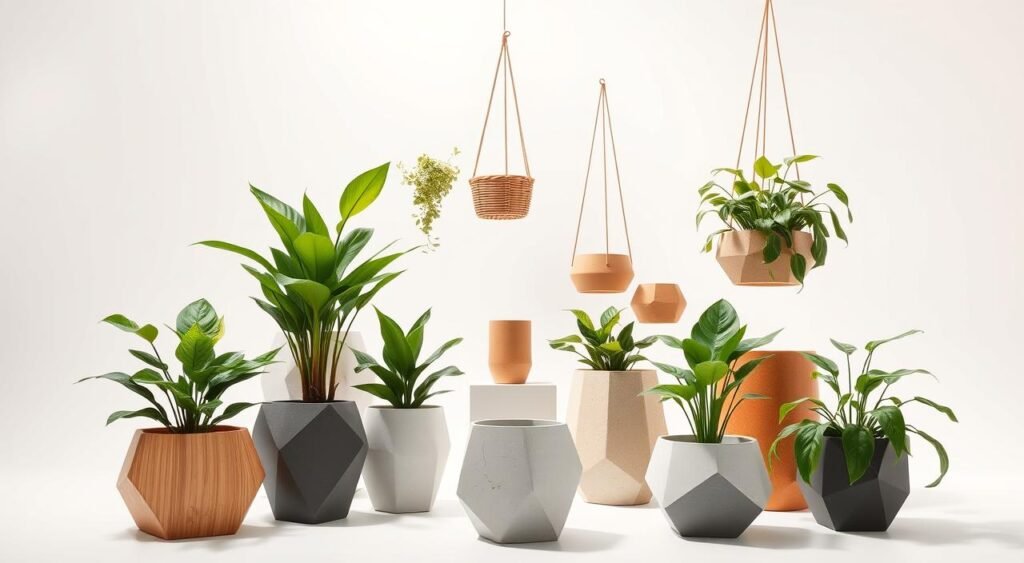
Eco-friendly planters merge sustainability with style, enhancing indoor spaces while nurturing air purifying plants. Biodegradable and recycled options reduce environmental impact, aligning with modern green living trends.
“Natural planters are a healthy alternative to plastics and painted metals, which can release harmful VOCs.”
Biodegradable Materials
Materials like coconut coir, bamboo, and rice hulls decompose naturally without harming ecosystems. Ecopots, for instance, uses CO2-neutral production methods, with pots lasting up to ten years. Brands like Bergs Potter craft terracotta from Italian clay, promoting airflow and moisture control. These materials ensure minimal waste, ideal for air purifying plants like snake plants or peace lilies.
- Coconut coir: Lightweight and breathable, supports root health.
- Bamboo fiber: Durable and compostable, often used in handmade planters.
- Compostable plastics: Break down safely, available in sizes from 3–40 inches.
Recycled Planters and Containers
Repurposed items like glass jars or tin cans cut waste while adding charm. The Sill’s handmade planters, crafted in Vietnam, offer stylish yet sustainable choices starting at $34. Metal and wood planters, like those from Areaware, are recyclable and available in sizes 4–8 inches. These options pair well with air purifying plants like rubber plants or dracaenas.
| Material | Benefits | Examples |
|---|---|---|
| Bamboo | Biodegradable, UV-resistant | Ecopots, The Sill |
| Recycled Plastic | Reduces landfill waste | West Elm, Areaware |
| Stone/Cement | Long-lasting, heat-resistant | Hawkins New York |
Opting for these options supports air purifying plants while reducing environmental footprints. Choose based on plant needs—like drainage for peace lilies or breathability for spider plants—and enjoy a greener home.
Unique Potting Solutions
Maximize your space with vertical and hanging planters designed for creativity and practicality. These innovative options turn small areas into lush displays without overcrowding.
Vertical Planters for Limited Space
Wall-mounted systems and stackable planters let you grow houseplants vertically. Pocket planters attached to walls create living green walls, ideal for small apartments. Choose lightweight materials like felt or fabric to reduce strain on walls. Trailing plants like string of pearls or philodendron thrive in these setups, cascading down pockets or shelves. When selecting plants, match their light needs to the wall’s exposure.
- Wall-mounted planters: Use felt or fabric for lightweight options
- Stackable designs: Perfect for narrow spaces
- Pocket planters: Attach directly to walls or shelves
Hanging Planters: Adding Dimension
Suspend indoor plants to add height and depth. Macramé hangers and ceiling planters distribute greenery upward, freeing floor space. Opt for sturdy chains or tension rods to handle plant weight. Plants like pothos or ivy cascade beautifully from above, softening room corners.
- Macramé hangers: Add bohemian flair while saving floorspace
- Window-mounted hooks: Ideal for small ferns or succulents
- Tension rod planters: Use in window frames for bright-light plants
| Type | Best Plants | Key Features |
|---|---|---|
| Vertical | String of pearls, pothos | Space-saving, vertical growth |
| Hanging | Ivy, spider plants | Height dimension, cascading foliage |
Budget-Friendly Container Ideas
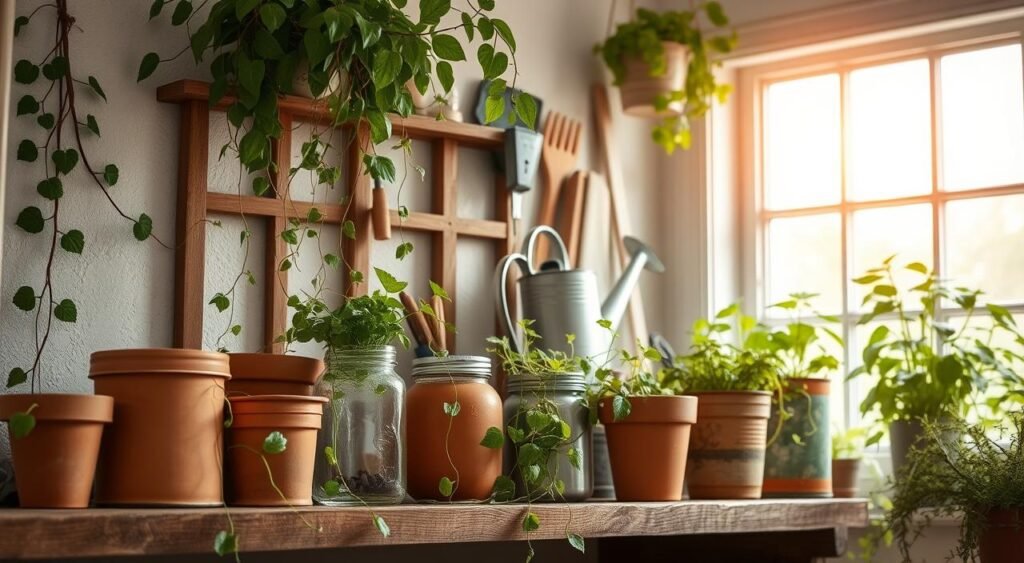
Thriving indoor gardening doesn’t require expensive containers. Start with affordable commercial options like plastic nursery pots, which cost as little as $3 each in bulk purchases. Discount stores often sell glazed or terracotta pots for under $10, making them ideal for small plants. Look for seasonal sales in spring or fall when retailers offer discounts on overstock inventory.
Affordable Planter Options
- Plastic pots: Durable and lightweight, available at big-box stores for $5-$15
- Repurposed items: Thrift-store ceramic bowls ($8-$12) or even plastic storage bins (under $5) work well with drainage holes drilled in
- Concrete sprays: Customize plain pots with $10 spray paint for instant decor
Upcycling Household Items into Planters
Transform everyday items into planters with these low-cost solutions:
| Item | Cost | Usage |
|---|---|---|
| Mason jars | $2-$5 | Perfect for herbs or air plants |
| Tin cans | Free-$3 | Drill drainage holes for succulents |
| Wooden crates | $7-$15 | Plant trailing vines in stacked crates |
Combining one large plant with underplantings cuts costs while maintaining visual appeal.
Repurpose old teacups ($4-$8) for small cacti or use old shoes as quirky planters. Prioritize drainage holes and non-toxi coatings when modifying items. Pair with cost-effective plants like spider plants (under $5) or pothos ($7-$10) for instant greenery. Even yogurt containers (free) can host seedlings until they mature.
Pro tip: Use pebbles from garden paths (free) as drainage layers instead of buying specialized materials. With creativity, indoor gardening budgets can stay under $20 per project.
Indoor Plant Care and Maintenance
Mastering watering and feeding routines is key to thriving indoor plants. Proper plant care ensures your greenery stays healthy, even in confined containers. These indoor plant care tips simplify maintenance while addressing challenges like root confinement and moisture balance.
Watering Tips for Potted Plants
Adjust watering based on plant type and container. For example, snake plants need watering once or twice weekly in spring, but reduce to monthly in winter. Overwatering causes root rot, the top cause of plant death. Use these steps:
- Test soil moisture by poking 1-2 inches deep.
- Water thoroughly until liquid drains out, then empty saucers to prevent root rot.
- Reduce watering in winter for most plants.
Fertilization: When and How to Feed
Feed plants during active growth seasons. Fertilization schedules vary:
- Use diluted fertilizers (like 50% strength for aloe, March-August).
- Apply balanced fertilizers during spring/summer for flowering plants.
- Avoid feeding in winter when growth slows.
Overfertilizing harms roots, so follow label guidelines and adjust for container size.
Popular Houseplants and Their Ideal Pots

Matching plants to the right containers boosts their health. Let’s explore how to pair best indoor plants with pots tailored to their needs.
Best Pots for Succulents
Succulents and cacti thrive in pots with fast drainage. Choose terracotta or unglazed ceramic to wick away excess moisture. Shallow containers prevent root rot, making them ideal for small spaces. Snake plants, a top low light indoor plant, prefer unglazed clay pots to reduce overwatering risks. Add gravel layers to boost drainage for these drought-tolerant varieties.
Choosing Pots for Ferns and Tropical Plants
Ferns and tropical plants like peace lilies need pots that retain moisture. Glazed ceramic or plastic containers trap humidity, keeping soil damp. Peace lilies, which bloom in low light, benefit from wide pots to accommodate their spreading roots. For humidity lovers like bird’s nest ferns, include a pebble tray under the pot to boost moisture levels. Tropical plants like calatheas grow best in containers with drainage holes but paired with humidifiers in dry climates.
Customizing Your Indoor Planters
Transform plain containers into unique pieces that boost indoor plant decor. Personalized planters let you merge creativity with practical care, turning everyday items into stylish accents.
“Upcycled containers and creative paint techniques make every planter unique, says DIY expert Anna Rose Johnson. This approach reduces waste and boosts home aesthetics.”
Painting and Personalizing Containers
Acrylic paint, chalk finishes, or stencils turn basic pots into art. Prep surfaces thoroughly and apply non-toxic sealers to safeguard plants. Quick projects like 20-minute acrylic painting kkk2 offer instant results. Experiment with marbled effects or geometric patterns using poured paint techniques kkk2. Repurpose jars, tin cans, or reclaimed wood to cut costs and reduce waste kkk1.
Adding Decorative Stones and Moss
Top dressings like river rocks, moss, or glass beads enhance drainage and style. Stones prevent soil erosion while adding texture. Try these options:
- River rocks: Improve airflow and moisture control
- Preserved moss: Adds organic flair and humidity retention
- Colorful glass beads: Match room color schemes
Choose materials that align with your space’s style, whether modern, rustic, or bohemian.
Brands like Hip Haven offer sleek options starting at $215 kkk3, while ferm LIVING provides geometric designs up to $459 kkk3. Budget-friendly picks like Design Within Reach’s Story Planter cost $79-$119 kkk3. Pair vibrant hues with neutral tones to maintain cohesive indoor plant decor schemes.
Balance creativity with plant needs. Avoid blocking drainage holes when adding stones. Test DIY techniques on small containers first to ensure root health. Seasonal rotations let you update looks without harming plants.
Indoor Plant Trends to Watch
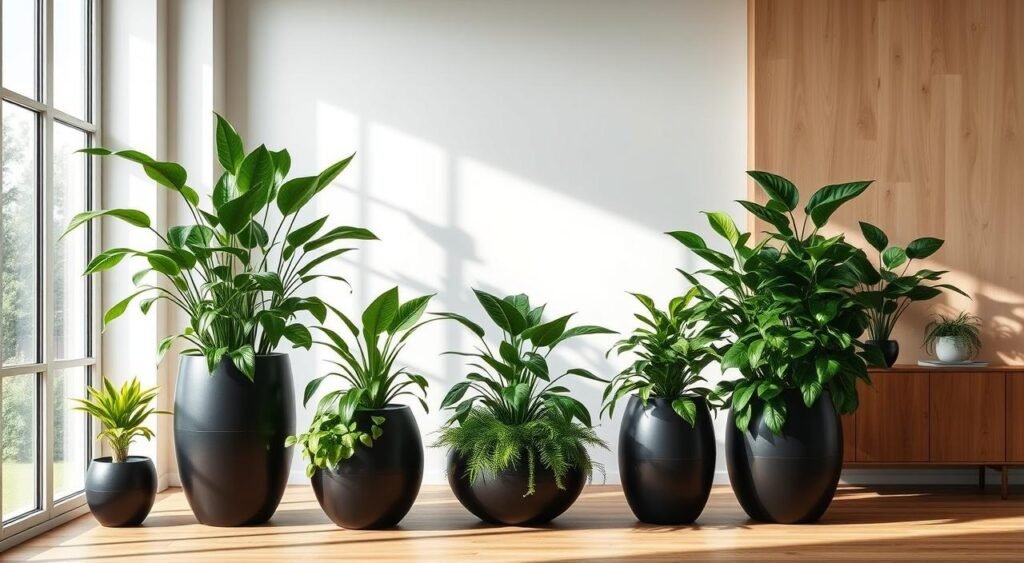
Modern indoor gardening is shifting toward eco-conscious choices and smart technology. Innovations in containers now prioritize sustainability while supporting air purifying plants like snake plants and spider plants, which thrive in these systems.
Sustainable Planting Practices
Biodegradable pots made from coconut coir or bamboo fiber are gaining traction, reducing plastic use in households. Retailers report a 40% rise in sales of recycled plastic containers since 2023. Popular options include:
- Clay pots with built-in drainage for succulents
- Vertical gardens using reclaimed wood frames
- Self-watering systems paired with air purifying plants like peace lilies
The Rise of Self-Watering Planters
Smart planters with moisture sensors now auto-adjust water levels for fiddle leaf figs and pothos. A 2024 study shows 65% of urban renters prefer these systems to avoid overwatering. Key features include:
| Feature | Benefit |
|---|---|
| Reservoir tanks | Keeps soil evenly moist for air purifying plants |
| Wicking systems | Reduces manual watering by 30% |
These trends reflect a shift toward eco-conscious living spaces. As more people prioritize health, self-watering containers enable even beginners to grow air purifying plants like ZZ plants without daily upkeep.
Seasonal Container Care for Indoor Plants
Adapting care routines to seasonal changes ensures indoor plants stay healthy year-round. These indoor plant care tips help manage light, water, and humidity shifts effectively.
Preparing Your Plants for Winter
Root rot is the #1 cause of winter plant deaths, so prioritize proper watering. Let soil dry between waterings to avoid overwatering—the top killer of houseplants. Move containers away from drafty windows and cold surfaces. Use pots with drainage holes and insulate roots with bubble wrap. Heating systems drop humidity to 10-20%, far below tropical plants’ 40-50% preference. Group plants to boost local humidity naturally; misting alone won’t work. Avoid repotting until spring to reduce stress. Fertilize lightly to avoid nutrient shortages.
Spring and Summer Container Refresh Strategies
Spring is ideal for repotting root-bound plants in fresh soil to support summer growth. Clean containers to remove salt buildup. Increase watering frequency as daylight hours lengthen—some plants may need weekly watering versus winter’s 2-3 week cycles. Fertilize regularly once new growth appears. Monitor soil moisture with sensors, as the finger test becomes unreliable in winter. In summer, adjust watering to match higher light exposure and growth rates.
Follow these indoor plant care tips to keep plants thriving through all seasons. Adjust watering, humidity, and light based on seasonal needs for long-term health.

